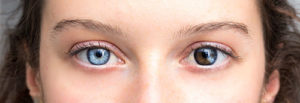Can I wear contact lenses with astigmatism?
 Astigmatism is a condition that affects your eye’s ability to focus on a particular subject or object within your view. People who have astigmatism are unable to see light evenly displayed on their retina. This can cause all sorts of issues, and it can also pose a safety risk in situations where people with this condition are driving at night or other instances where your vision is extremely important.
Astigmatism is a condition that affects your eye’s ability to focus on a particular subject or object within your view. People who have astigmatism are unable to see light evenly displayed on their retina. This can cause all sorts of issues, and it can also pose a safety risk in situations where people with this condition are driving at night or other instances where your vision is extremely important.
Blurry vision and astigmatism
Blurry vision is one of the most common signs that you have astigmatism. Many people who suffer from this condition often ask the question, “Can I wear contact lenses with astigmatism?” and the answer to that question is everything but simple.
There are many variables that come into play when trying to figure out whether you can wear contacts with astigmatism. If you’re dealing with astigmatism and want to learn more about whether you’ll wear contacts or not, continue reading below.
Can I wear contact lenses with astigmatism?
If you have astigmatism, the good news is that you still will be able to wear contact lenses. However, you must consider the fact that astigmatism can impact your vision in a very adverse manner when left untreated for prolonged periods of time.
You should only use contact lenses that are specifically designed for people with astigmatism because if not, you can experience increased retina irritation. Astigmatism can be slightly corrected with the right type of contact lenses as long as you make sure that you speak with your eye doctor first.
Since astigmatism contact lenses are designed for those people with specific vision problems, it’s not recommended that you wear them unless you have the condition. Doing so can lead to all sorts of issues that may not be currently present. Before getting a contact lens prescription, you will have to go through a comprehensive contact lens exam.
Advancements over time have made wearing contacts with astigmatism much more comfortable than it was in previous times. One of the most commonly recommended types of contact lenses for people who suffer from astigmatism is toric lenses. Toric lenses are designed with vertical and horizontal axes, which allows you to achieve varying levels of corrective power.
Choosing the right contact lens
Toric contact lenses are great because they go with the natural gravity and motion of your eyes. At all costs, avoid wearing any eyewear that is not made specifically for astigmatism as this can lead to the development of more serious vision problems.
To make sure you select the right contact lenses, make sure you speak with your vision specialist so that you will know for sure you’re making the right choice. In certain instances, you can request custom contacts that will allow you to get a personalized solution to your vision problem.
If you’re someone who has been wondering, “Can I wear contact lenses with astigmatism?” the answer is yes.
People Also Ask
Q: Can you wear regular contact lenses if you have astigmatism?
A: No, if you have astigmatism, it’s essential that you wear specialized contact lenses because your condition can worsen if not. Regular contact lenses do not cover your cornea’s entirety, which will impair your ability to see even further. The best option to go with if you want to wear contact lenses with astigmatism is to wear astigmatism contact lenses.
Q: Are contacts for astigmatism uncomfortable?
A: Wearing contact lenses, in general, isn’t the most comfortable thing to do in the world. Being that astigmatism already impairs your ability to see clearly, wearing contacts can compound the discomfort you experience while wearing them. However, over time you will eventually become used to the feeling of wearing contact lenses.
Q: What kind of contact lenses are best for astigmatism?
A: Some of the best contact lenses to wear when you have astigmatism are Acuvue Oasys, Air Optix, and Biofinity Toric.
Knowing how to find the right contact lenses
Now that you know more about how to find the right contact lenses to wear for your astigmatism, use all of this information so that you can ensure you can see as clearly as possible. Before choosing which contact lenses are best for you, ask yourself these two simple questions “How severe is my astigmatism?” “Will contact lenses help my astigmatism?”
 Heterochromia
Heterochromia